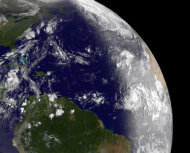The
Kepler spacecraft has discovered 11 new planetary systems hosting 26 confirmed planets, the National Aeronautics and Space Administration, NASA, announced Thursday. These discoveries nearly double the number of verified planets and triple the number of stars known to have more than one planet that passes in front of its star.
These exoplanets, outside the Earth's solar system, orbit close to their host stars and range in size from 1.5 times the radius of Earth to larger than Jupiter, the largest planet in Earth's solar system.
"Prior to the Kepler mission, we knew of perhaps 500 exoplanets across the whole sky," said Doug Hudgins, Kepler program scientist at NASA Headquarters in Washington.
Of the more than 700 exoplanets now confirmed, only a handful are known to be rocky, like the Earth.
In size, 15 of the newly discovered planets are between Earth and Neptune, which is 17 times the mass of Earth.
The exoplanets orbit their host stars once every six to 143 days. All are closer to their host stars than Venus is to our Sun.
Kepler identifies planet candidates by repeatedly measuring the change in brightness of more than 150,000 stars to detect when a planet passes in front of the star. That passage casts a small shadow toward Earth and the Kepler spacecraft.
Each of the new confirmed planetary systems contains two to five closely spaced transiting planets.
In tightly packed planetary systems, the gravitational pull of the planets on each other causes some planets to accelerate and some to decelerate along their orbits. The acceleration causes the orbital period of each planet to change.
Kepler detects this effect by measuring the changes, or so-called Transit Timing Variations, TTVs.
Planetary systems with TTVs can be verified without requiring extensive ground-based observations, accelerating confirmation of planet candidates. The technique also increases Kepler's ability to confirm planetary systems around faint, distant stars.
Five of the systems (Kepler-25, Kepler-27, Kepler-30, Kepler-31 and Kepler-33) contain a pair of planets where the inner planet orbits the star twice during each orbit of the outer planet.
Four of the systems (Kepler-23, Kepler-24, Kepler-28 and Kepler-32) contain a pairing where the outer planet circles the star twice for every three times the inner planet orbits its star.
"These configurations help to amplify the gravitational interactions between the planets, similar to how my sons kick their legs on a swing at the right time to go higher," said Jason Steffen, the postdoctoral fellow, and lead author of a paper confirming four of the systems.
Kepler-33, a star that is older and more massive than our Sun, had the most planets yet discovered. The system hosts five planets, ranging in size from 1.5 to five times that of Earth.
The decrease in the star's brightness and duration of a planet's transit in front of its star, combined with the properties of its host star, present a recognizable signature, the scientists say.
When astronomers detect planet candidates that exhibit similar signatures around the same star, the likelihood of any of these planet candidates being a false positive is very low.
At least three transits are required to verify a signal as a planet. Follow-up observations from ground-based telescopes confirm the discoveries.
These findings are published in four separate papers in the "Astrophysical Journal" and the "Monthly Notices of the Royal Astronomical Society."

 美國太空總署(NASA) 1月26日發佈消息,說明克卜勒太空望遠鏡新發現11個系外行星系統,其中確認有26顆行星。現在,人們所知的銀河行星數量,增加為2倍以上,有一顆以上行星環繞的「多行星恆星」,則增加為3倍以上。
美國太空總署(NASA) 1月26日發佈消息,說明克卜勒太空望遠鏡新發現11個系外行星系統,其中確認有26顆行星。現在,人們所知的銀河行星數量,增加為2倍以上,有一顆以上行星環繞的「多行星恆星」,則增加為3倍以上。 克卜勒太空望遠鏡觀察光度變化的方法、叫作凌日時間變分法(Transit Timing Variations, TTVs,和凌日法有關),來發現這種星體間、微妙的交互作用所造成的太空現象。
克卜勒太空望遠鏡觀察光度變化的方法、叫作凌日時間變分法(Transit Timing Variations, TTVs,和凌日法有關),來發現這種星體間、微妙的交互作用所造成的太空現象。 博士後研究員、也是確認4個行星系統的論文主要作者斯蒂芬(Jason Steffen)談道,「以上這些繞行的模式,讓我們對引力和行星間的交互作用,了解更深;就好像我的兒子盪鞦韆,越來越能抓準踢腿時機,能盪得更高。」
博士後研究員、也是確認4個行星系統的論文主要作者斯蒂芬(Jason Steffen)談道,「以上這些繞行的模式,讓我們對引力和行星間的交互作用,了解更深;就好像我的兒子盪鞦韆,越來越能抓準踢腿時機,能盪得更高。」